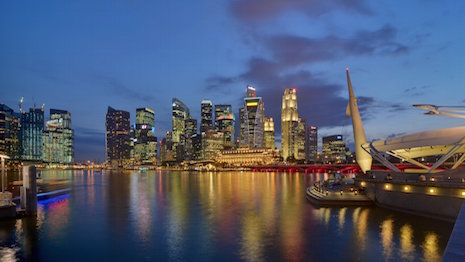- About
- Subscribe Now
- New York,
May 31, 2017

 Outside of China, Singapore is one of the few Asian nations that has a healthy luxury market
Outside of China, Singapore is one of the few Asian nations that has a healthy luxury market
The global luxury market is expected to bounce back this year with predicted growth of 2 to 4 percent, according to a new joint report from Altagamma and Bain & Company.
This growth can be attributed to a healthy desire for luxury goods from Chinese consumers, many of whom buy their luxury products internationally. Additionally, increased consumer confidence in Europe is also driving luxury's growth.
“This year looks promising so far,” said Claudia d'Arpizio, lead author of the study, Bain & Company, Milan. “After a difficult 2016, the first quarter of 2017 brought some relief to the luxury industry.
"Factors such as the continuous repatriation of Chinese consumption as well as a positive outlook in Europe both for locals and tourists will help drive overall market growth during the remainder of the year,” she said.
First quarter growth
2016 was not the best year for luxury. Growth was down overall and many in the industry were anxious to see how things would fare this year.
So far, early reports are good, with Bain predicting a 2 to 4 percent growth in the overall luxury market to around $250 billion globally and $290 billion by 2020.
In its "Luxury Study Update for 2017," Bain and Altagamma found that the repatriation of Chinese consumption is driving the new growth in the first quarter of 2017.
The United States is currently underperforming, with economic issues and political uncertainty marring its luxury spending. Latin America and Canada are also performing slowly, but not without some support.
Overall, the Americas are expected to see negative growth for the rest of the year.
“The Bain study is accurate," said Robert Steele, co-founder of World's Best. "China will not only continue to grow in importance in the luxury market due to its wealth but also in terms of the importance of the appetite for unique and bespoke merchandise.
"Wealthy Chinese consumers go beyond just buying recognized brands. Now more than ever, there’s an appetite for rare and unique merchandise including custom jewelry and even a $10 million custom Rolls Royce as was reported recently.
"China is definitely an important market with significant growth opportunity. One area we're seeing a demand for is custom one-of-a-kind experiences such as travel and real estate which we will be adding to our collections.”
Threats and instances of terrorism hurt the European tourism industry badly in 2016, but some areas of Europe are beginning to rebound, such as Spain, which is commonly viewed as “safer” than somewhere such as France or the United Kingdom.
China is a driver of much of luxury's current growth. While the conventional knowledge is that Chinese consumers buy most of their luxury goods while abroad, at home luxury spending is increasing and is expected to drive 6 to 8 percent of overall luxury growth.
The rest of Asia is far less luxury-oriented, save for Singapore, Hong Kong and Japan, which have seen some growth.
The Chinese connection
China’s emergence in the luxury world has been a well-known fact for the last year or so, with many brands beginning to research how best to reach out to Chinese customers.
Speaking at the DLD NYC conference in New York on May 12, L2’s head of APAC research spoke about the Chinese shopping landscape and the stark ways it differs from other countries. The biggest difference is in the digital platforms Chinese shoppers use to purchase products (see story).
"First and foremost, the tremendous impact of online shopping that has resulted in the upheaval of mainstream retail is now moving to the luxury segment," said Kevin Chow, co-founder of World's Best. "This is the biggest and most lucrative opportunity in ecommerce.
"Already we are witnessing the struggles of luxury store retailers such as Nordstrom, Neiman Marcus and Michael Kors. Flagship stores are even planning to leave Fifth Avenue. The traditional luxury model of forcing affluent customers to travel and shop at physical stores is breaking down as online luxury alternatives emerge.
"There's a need for a real overhaul in the online experience if businesses and retailers hope to capitalize on these learnings. You have to adapt to your customers’ lifestyle and in this case, it's one that's on the move and you need to be there with them online."
Other research has found that influencer posts on social media are eight times more popular than brand posts in China, meaning that influencers are one of the primary ways that luxury brands can reach Chinese customers.
Spain is one part of Europe where luxury spending has remained steady
L2’s Digital IQ Index China: Luxury 2017 report looked at different luxury brands and how they are performing in the Chinese market. What the report found was that familiarity with China’s unique digital platforms leads to better performance, particularly when engaging with Chinese influencers on social media (see story).
With the overall luxury market on the rise, luxury brands can thank China for the small amount of growth the industry is currently experiencing on a global level.
“Brands need to be customer obsessed and millennial minded,” said Bain's Federica Levato, partner and co-author of the report, Milan. “Buying a luxury good now is not just walking into a store.
"It has become a journey of engagement through multiple touchpoints well before the point of sale,” she said.
Share your thoughts. Click here